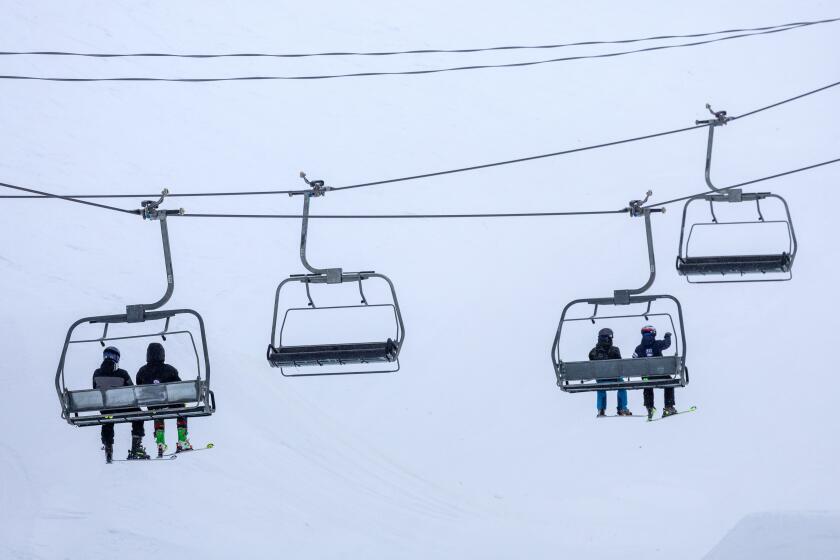Chevron to Pay $1.2 Million for Safety Violation
- Share via
Chevron U.S.A. agreed Wednesday to pay nearly $1.2 million for operating an oil well off the Ventura County coast with a broken anti-blowout valve, which authorities said is the most important safety feature on an oil platform because it halts the flow of oil during emergencies.
The lawsuit settlement announced by federal prosecutors represents the largest fine ever for violations of the federal Outer Continental Shelf Lands Act, eclipsing a $1-million penalty against Chevron in 1970 for safety violations in the Gulf of Mexico.
The new penalty is also the second huge fine against Chevron for legal violations on the same Santa Barbara Channel oil rig. In 1992, the company paid $8 million for repeatedly dumping oil, grease and other toxic wastes into the ocean.
“No one wants another Santa Barbara oil spill,” U.S. Atty. Nora M. Manella said Wednesday in Los Angeles, referring to a 1969 rupture beneath an offshore platform. “Rigorous enforcement of safety regulations . . . is our best guarantee against the catastrophic consequences of future oil spills.”
Chevron officials acknowledged having operated a well on the Grace Platform 13 miles off Port Hueneme that pumped for several months in 1994 with a faulty valve that could not have stopped the flow of oil from beneath the ocean floor if severe problems had developed.
But company spokesman Ed Spaulding emphasized that a massive spill such as the one that coated Santa Barbara County beaches with oil for years was never a possibility.
Even if a fire or pipeline rupture had occurred without a working shut-off value, the pressure from the oil reservoir beneath Chevron’s platform is so low that ocean water would have held most of the oil in its basin, he said.
“Clearly there would have been some minor amounts of leakage, but there would not have been a massive release of oil,” Spaulding said.
Top Chevron officials said they should have fixed the faulty valve more quickly, but that failure to do so did not lead to any environmental damage.
“We regret the incident,” Spaulding said. “But we made some changes in both responsibility and also some personnel changes, and the problem has not been repeated.”
According to prosecutors and the company, Chevron discovered during a routine maintenance inspection in 1994 that a shut-off valve about 100 feet beneath the ocean floor was not fully closing when it should. Spaulding said the repair was ordered internally, but never occurred.
Assistant U.S. Atty. Kurt Zimmerman said federal inspectors found the same problem during their own routine inspection in September 1994--five months later--and it was only then that Chevron shut the well down and repaired the valve.
In the government’s civil complaint, Zimmerman said the company created conditions that posed “unreasonable risk to public health, life, property, aquatic life, wildlife, recreation, navigation, commercial fishing and other uses of the ocean.”
*
Zimmerman also noted that Chevron pleaded guilty five years ago to 65 violations of the Clean Water Act for dumping toxics from Grace Platform into the ocean.
The company agreed to pay $6.5 million in criminal penalties--then the third-largest environmental criminal fine ever assessed against a company--and another $1.5 million in civil penalties to settle the case.
But in a statement Wednesday, Carnie Block, a Chevron vice president, said his company’s safety record has been exemplary, as shown by three commendations since 1991 from the U.S. Minerals Management Service--the same federal agency that discovered the broken safety valve.
Platform Grace, constructed in 1979, and its companion rig, Gail, erected in 1987, have produced 27 million barrels, or 1.13 million gallons so far, officials said. They are among five platforms Chevron plans to shut down soon because low oil pressure and high pumping costs make the operations uneconomical.
*
Chevron’s regional headquarters was in Ventura until it moved to Bakersfield in 1990, and the San Francisco-based company’s regional operations center is still here, employing about 250 workers.
Wednesday’s settlement must still be approved by a federal judge. The money will go into the U.S. Treasury.
More to Read
Sign up for Essential California
The most important California stories and recommendations in your inbox every morning.
You may occasionally receive promotional content from the Los Angeles Times.










